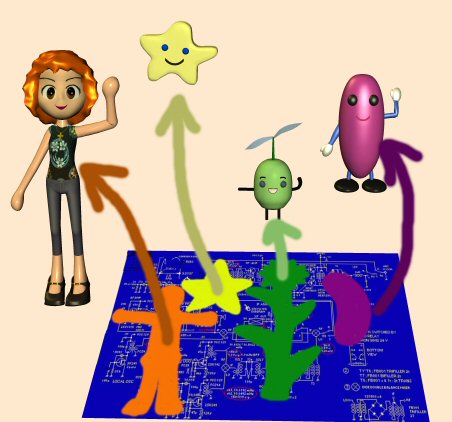Sunday, July 17, 2011
Grand Blueprint again
Polistra has been following an emerging theme in biology. More and more evidence is piling up in all sorts of ways, pointing to the idea of a Grand Blueprint. Life didn't gradually build from inorganic chemicals to its current level of complexity by a near-infinite set of completely random steps. Instead, it looks like the full range of complexity was present in an original DNA blueprint, and all existing lines of animals, plants and protists are simply selected scraps from the full blueprint. The scraps have been modified along the way, and new genes have been added; nevertheless, the main direction is simplification, not complexification.

A dramatic and clear statement of the new direction appears in a New Superstitionist feature [subscription only] about the fading line between bacteria and other cells.
I'm still puzzled that the Intelligent Design folks haven't focused hard on this set of developments. ID'ers seem to be whirlpooling around an unproductive cul-de-sac of statistical details, trying to refine a measurement for complexity or something like that.
= = = = =
Artistic note: the cartoon would be more accurate with strongly overlapping 'selection zones', showing that most living things have most genes in common, but it's more readable this way.

A dramatic and clear statement of the new direction appears in a New Superstitionist feature [subscription only] about the fading line between bacteria and other cells.
To have one trait possessed by complex cells - membrane-bound DNA - could be a coincidence. To have two seems unlikely. What's more, most members of the larger group that G. obscuriglobus belongs to ... have proteins that are very similar to those that control endocytosis in eukaryotes. The big question is whether this is a case of parallel evolution, or whether complex cells and bacteria shared a common ancestor capable of endocytosis.
If there is a common ancestor, the implications are huge. It means the shared ancestor, known as the last universal common ancestor, or LUCA, must have been much more complex than previously assumed. ... This would turn our picture of how life evolved on its head.
Rather than being "primitive" cells, modern bacteria may be streamlined, simplified versions of a more complex ancestor. Perhaps they are not so much prokaryote as "post-karyote."
I'm still puzzled that the Intelligent Design folks haven't focused hard on this set of developments. ID'ers seem to be whirlpooling around an unproductive cul-de-sac of statistical details, trying to refine a measurement for complexity or something like that.
= = = = =
Artistic note: the cartoon would be more accurate with strongly overlapping 'selection zones', showing that most living things have most genes in common, but it's more readable this way.
Labels: Grand Blueprint
